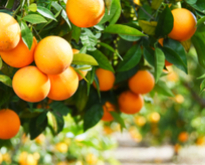The Member States of the European Union (EU) harvested 6.5 million tonnes of oranges in 2018. This was the highest production level since 2010 and was underpinned by the record harvest in Spain (3.6 million tonnes of oranges, or 56% of the EU total).
Climatic requirements for oranges mean that production is limited to a handful of Member States. Apart from Spain, the other main producer countries were Italy (1.6 million tonnes, or 24% of the EU total) and Greece (0.9 million tonnes, or 14% of the EU total).
Almost 274 000 hectares (ha) of oranges were cultivated in 2018, with just over one half of this total area being in Spain (140 000 ha). Italy had the next highest area given over to the production of oranges (83 000 ha, 30% of EU total), followed by Greece (32 000 ha, 12% of EU total).
The source dataset is accessible here.
Majority of trade in oranges took place within the EU
Almost 2.7 million tonnes of oranges, with a value of €1.9 billion, were exported by Member States in 2018. The vast majority of these exports (2.3 million tonnes, or 88% of the total) were traded between Member States (so-called intra-EU trade).
Among EU Member States, Spain exported the most oranges to non-EU countries (161 000 tonnes, or 51% of the extra-EU exports).
The source dataset is accessible here.
About three quarters of oranges imported to the EU came from South Africa and Egypt
The EU imported 1.1 million tonnes of oranges, to the value of €0.7 billion, from non-EU countries in 2018. About three quarters of these imports came from either South Africa (465 000 tonnes, or 43% of the total extra-EU imports of oranges in 2018) or Egypt (328 000 tonnes, 30%).
Most of the rest of the EU’s imports of oranges came from Morocco (89 000 tonnes, 8%), Argentina (44 000 tonnes, 4%), Zimbabwe (39 000 tonnes, almost 4%), Türkiye (29 000 tonnes, 3%) and Uruguay (27 000 tonnes, 2%).
To contact us, please visit our User Support page.
For press queries, please contact our Media Support.

